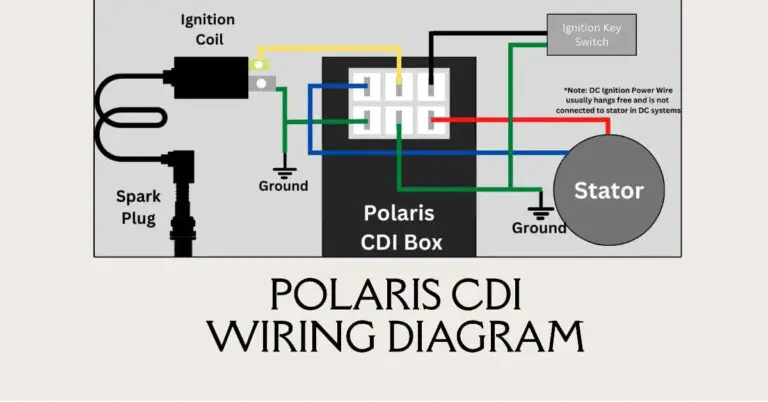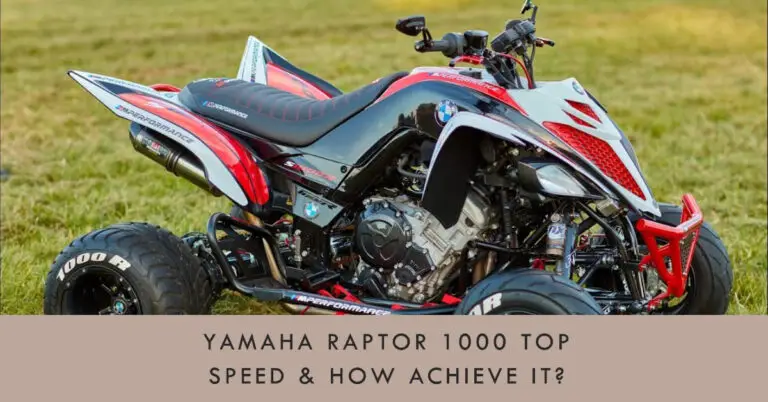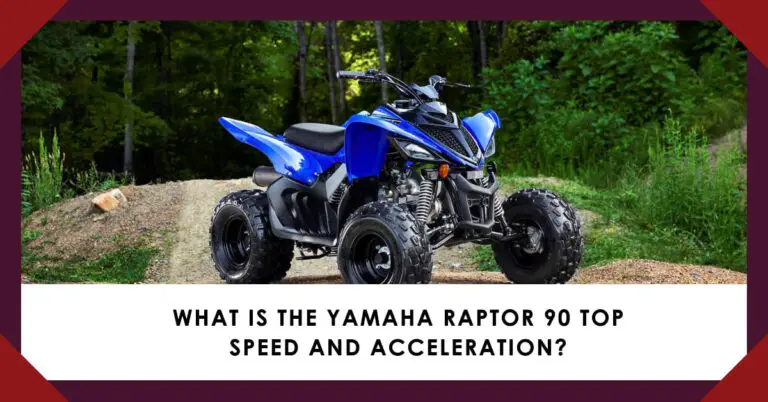Yamaha Raptor 350 Review: Specs, Pros, Cons, and Expert Tips

Are you considering buying a used Yamaha Raptor 350 ATV? As one of the most popular sport quads ever made, the Raptor 350 has a huge fan base to this day. But is it the right ATV for you?
In this Yamaha Raptor 350 review, we’ll cover everything you need to know:
- Key specs and features
- Real world performance
- Handling impressions
- Reliability issues to look out for
- Common questions and expert tips for buyers
After reading this comprehensive Raptor 350 review, you’ll be able to decide if this legendary sport ATV is a good match for your needs and budget. Let’s get started!
Table of Contents
Yamaha Raptor 350 History
Before diving into the nitty-gritty details, let’s briefly cover the history behind the Raptor 350. Yamaha first introduced this sport ATV back in 2001 as a lighter, nimbler alternative to the larger Raptor 660R.
The original Raptor 350 featured a 348cc air-cooled single-cylinder four-stroke engine, five-speed manual transmission, and long-travel suspension. It was an immediate hit with recreational and youth riders looking for a powerful but manageable mid-sized sport quad.
Over its production run spanning 2001-2005, the Raptor 350 received updates like new colors and graphics. But Yamaha wisely avoided making major changes that would alter the winning formula.
Production ended after the 2005 model year as emission regulations tightened. But the Raptor 350’s legacy lives on thanks to its huge following as one of the most rider-friendly sport ATVs ever built.
Now let’s take a closer look at this legendary machine.
Yamaha Raptor 350 Specs and Features
| Spec | Measurement |
|---|---|
| Engine | 348cc air-cooled single-cylinder 4-stroke |
| Bore x stroke | 86mm x 68mm |
| Compression ratio | 9.2:1 |
| Fueling | Keihin CVK36 carburetor |
| Starting | Kickstart |
| Transmission | 5-speed manual |
| Drive system | Rear-wheel 2WD/4WD selectable |
| Swingarm suspension travel | 9.1 in (front), 10.6 in (rear) |
| Suspension | Independent double wishbone (front), swingarm (rear) |
| Brakes | Dual hydraulic disc |
| Tires | AT20 x 7-10 (front), AT19 x 10-9 (rear) |
| Wheelbase | 48.8 in |
| Seat height | 31.7 in |
| Ground clearance | 4.3 in |
| Fuel capacity | 2.1 gal |
| Dry weight | 379 lb |
Key Features:
- 348cc 4-stroke engine produces broad power
- 5-speed manual transmission with reverse
- Switchable 2WD and 4WD drive modes
- Long-travel suspension soaks up rough terrain
- Nimble handling from compact chassis
- Hydraulic disc brakes on both wheels
- Steel skid plate for added durability
- Smooth-adjusting clutch for easy launches
- Comfortable ergonomics for a wide range of riders
Yamaha Raptor 350 Performance and Power
Now let’s discuss how the Yamaha Raptor 350 performs in the real world. Motivating this sporty ATV is a 348cc air-cooled single-cylinder four-stroke engine.
This proven powertrain pumps out a very linear, tractable powerband. There are no big hits in the power curve. Just smooth, steady acceleration from idle to the Raptor 350’s 7,500 RPM redline.
Throttle response is crisp without being overly sensitive. This makes the Raptor easy to control even for beginner riders. There’s enough low-end grunt for technical trail riding. And the motor revs quickly for aggressive fun in open areas.
While not lightning fast, the Raptor 350 has plenty of mid-range punch for wheelies, jumps, and having a blast on trails and dunes. In stock form, real world top speed is around 70 mph depending on conditions and rider weight.
The 5-speed transmission shifts smoothly with well-spaced gear ratios. Finding neutral is easy while stopped. The clutch has a light pull and linear engagement for confident launches and shifts.
Overall the Raptor 350 engine provides excellent power characteristics for recreational sport riding. Fast and fun without being intimidating. There are plenty of inexpensive bolt-on mods like exhausts and programmers available to add even more grunt if desired.
Yamaha Raptor 350 Handling and Suspension
In terms of chassis performance, the Yamaha Raptor 350 is nimble and agile feeling. At just 379 pounds dry weight, this ATV is very flickable and easy to maneuver. The compact size also makes the Raptor 350 feel less bulky and overweight compared to bigger 450cc and higher sport quads.
High speed handling is confidence inspiring. The Raptor 350 tracks straight and goes where you point it. The throttle-limiting governor can be adjusted for a larger wheelies zone.
Slow speed handling is excellent thanks to the light overall weight. The Raptor turns very easily side to side for navigating thick woods and technical sections. The turning radius is tight enough for nearly pivot turns.
Suspension components like the shocks and A-arms are high quality on Yamaha ATVs. The 9.1 inches of travel up front and 10.6 out back soak up bumps and ruts very plushly. You can push this machine hard into rough sections and land big jumps without harsh bottom outs.
Yamaha got the ergonomics right too. The slim seat and tank allow riders to easily slide forward and shift their body weight as needed. The handlebars are rubber mounted to reduce fatigue. And the brake levers offer good feel and modulation.
Used Yamaha Raptor 350 Pricing by Model Year
Here is a table showing typical used pricing for the Yamaha Raptor 350 by model year:
| Model Year | Used Price Range |
|---|---|
| 2001 | $2,800 – $3,500 |
| 2002 | $3,000 – $3,800 |
| 2003 | $3,200 – $4,000 |
| 2004 | $3,500 – $4,300 |
| 2005 | $3,800 – $4,500 |
Pricing will vary based on overall condition, service history, mileage/hours, and any upgrades or accessories added. Well-maintained examples on the lower mileage side with no issues will fall at the higher end of the ranges shown above. Higher mileage and more worn models will be priced at the lower ends.
Factors that increase value include added features like electric start kits, exhaust systems, suspension upgrades, nerf bars, and so on. Poorly installed accessories or mods could decrease value.
Overall, when shopping for a used Yamaha Raptor 350 ATV, expect to pay $3,000 to $4,500 for a decent condition machine, and up to the high $4Ks for a really clean, low hour example. Just be sure to thoroughly inspect any used Raptor 350 before purchasing.
Reliability – Common Yamaha Raptor 350 Problems
The Yamaha Raptor 350 has proven to be a very reliable ATV when properly maintained. The overall build quality and durability is excellent. But like any machine, the Raptor 350 has some common issues to watch out for:
- Starter issues – The kickstart is reliable, but many owners install an electric starter for convenience. Check electric starter operation if equipped.
- Idle adjustment – Idle speed screws often vibrate loose. Check and adjust the idle speed for smooth running.
- Rear axle bearings – Rear wheel bearings tend to wear out prematurely. Listen for any grinding noises from the rear.
- Speedometer/odometer – Mechanical speedometer cables can break or loosen over time. Test that the speedo works properly.
- Front diff seals – Front differential oil seals commonly leak. Watch for any wetness near the front diff housing.
- CV boot tears – The CV boots on the A-arm joints crack easily. Inspect boots for damage/tears which require replacement.
- Shifting issues – Hard shifting or popping out of gear can indicate worn shift forks. Check for sloppy shifter movement.
- Engine top end – High hour engines may need a rebuild. Check for good compression and smooth power.
- Swingarm bearings – Rear swingarm needle bearings wear over time. Listen for any “grinding” sounds from the rear suspension.
- Radiator – The plastic end tanks on the radiator often crack with age. Inspect for any leaking coolant.
- chassis cracks – Inspect the plastic bodywork and aluminum frame for any cracks or damage. Especially around the handlebar mounts.
Issues like worn wheel bearings, CV boots, and top end rebuilds come with the territory for used ATVs. As long as the seller is transparent about any fixes needed, a high mile Raptor 350 can still make an excellent and reliable machine for trail riding. Just be diligent during your inspection.
Is the Yamaha Raptor 350 Good for Trail Riding?
With its easy handling, plush suspension, and flexible powerband, the Raptor 350 is an excellent match for recreational trail and woods riding. It’s nimble enough for tight, technical singletrack. Yet has the suspension and ground clearance to blast down rough trails.
The 2WD mode works great on flat, loose trails where pushing the front end is a plus. Engaging 4WD provides added traction in mud and on steep inclines. Yamaha’s On-Command push-button 4WD system is convenient and effective.
Low gearing gives the Raptor 350 excellent control in tight sections. You can lug along at walking pace without stalling. The peppy mid-range means you can blast out of corners and up short hills. Less time spent shifting gears equals more time riding.
For riders looking to upgrade from a 90cc youth ATV, the Raptor 350 makes an excellent transitional model. Its mellow power delivery is confidence inspiring for beginners. Yet the chassis leaves room to progress your skills and become a faster rider over time.
What Owners are Saying About the Yamaha Raptor 350?
The Yamaha Raptor 350 has earned outstanding reviews and feedback from owners over the years. Here’s what current and past Raptor 350 riders have to say:
“The power is smooth and manageable, but still has plenty of grunt for recreational trail riding. I’ve owned mine for 5 years and it has never let me down.”
“This ATV is so fun to ride. It’s very nimble and easy to whip around on the trails. The suspension is plush and handles rough terrain very well.”
“I bought my Raptor 350 used as my first ATV. It has been the perfect quad to learn on. The throttle is very forgiving which gave me confidence as a beginner rider.”
“The build quality is excellent. I have thousands of miles on my Raptor 350 and it still runs fantastic. As long as you do proper maintenance, it’s very reliable.”
“For the price, you can’t beat the Raptor 350 if you can find a good used one. It’s a great all-around recreational sport quad that holds its value.”
“I’m 6′ 3″ and do feel a bit cramped on the Raptor 350. Wish the ergos were roomier for taller riders. But it’s amazingly capable and fun to ride.”
“Awesome sport ATV for youth and smaller riders moving up from a 90cc model. My son feels right at home on the Raptor 350 after outgrowing his smaller quad.”
What Type of Maintenance Does the Yamaha Raptor 350 Require?
As with any machinery, proper maintenance is key to the Yamaha Raptor 350’s longevity. Here are the most important maintenance tasks:
- Oil changes – Yamaha recommends changing engine oil every 20-40 hours. Use quality 10W-40 or 15W-40 4-stroke oil and a new filter.
- Air filter – The air filter needs cleaned every few rides and oil reapplied. Replace it whenever very dirty. Use OEM spec filters only.
- Tires – Check tires pressures before each ride (4-6psi front, 6-8psi rear). Inspect tread depth regularly and replace worn tires.
- Brake pads – The brake pads will need replacement once worn. Inspect pad thickness periodically.
- CV Boots – Check the CV joint boots for any cracking/damage which require replacement to avoid joint failure.
- Chain – Lubricate the chain and check adjustment before every ride. Replace worn chain and sprockets.
- Bolts/fluids – Check all nuts/bolts, top up fluids, and inspect components for any issues with each oil change.
Following the service intervals outlined in the owner’s manual is highly recommended. While the Raptor 350 motor is quite reliable, regular maintenance will maximize the life of the engine and components.
Many owners install popular upgrades like wider footpegs, reinforced A-arms, exhaust systems, and beefier swingarm skids to improve functionality and durability for more extreme riding. Aftermarket parts availability remains excellent.
5 Key Specs and Features
To summarize the Yamaha Raptor 350’s main specs and features:
- 348cc air-cooled engine – Proven 348cc 4-stroke motor provides usable power. Air cooling eliminates radiator leaks.
- Lightweight handling – 379 pound dry weight gives very nimble feel. Easy to ride and control.
- Plush suspension – 9.1 inches front and 10.6 rear soak up rough terrain. Quality components.
- Switchable 2WD/4WD – Convenient push-button allows switching between 2WD and 4WD modes. Great for trails.
- Reliability – Durable construction. Quality Yamaha build. Long-lasting with proper maintenance.
The Raptor 350 strikes an excellent balance between power and nimbleness. And provides great capability whether trail riding or having fun in the dunes and fields.
Yamaha Raptor 350 Pros and Cons
Pros
- Strong 348cc engine with smooth power
- Light, nimble handling
- Plush long-travel suspension
- High build quality and reliability
- Hydraulic disc brakes
- Comfortable ergonomics
- Huge aftermarket parts selection
Cons
- Discontinued model, limited availability
- Few convenience features
- Less ground clearance than taller ATVs
- Harder kickstarts when engine is hot
- Parts may be harder to find
For many riders, the Raptor 350’s abundant pros easily outweigh the short cons list. It’s an incredibly capable and fun-to-ride sport ATV. But taller riders may find it a bit cramped. And part availability is reduced since this model is no longer in production.
Frequently Asked Questions
What is the Yamaha Raptor 350 top speed?
The Yamaha Raptor 350 top speed is around 70 mph when bone stock. With a performance exhaust, air filter, and proper clutching it can reach 75+ mph.
How much does a used Yamaha Raptor 350 cost?
Used Raptor 350 prices typically range from $2,500 for a higher mileage unit up to around $4,500 for an excellently maintained, low hour example.
How fast is the Raptor 350 and what is the 0-60 time?
Yamaha lists the 0-30mph time at just 2.5 seconds. 0-60mph takes just over 5 seconds stock. The Raptor 350 provides brisk acceleration for a mid-sized ATV.
What is the Raptor 350 engine size?
The Yamaha Raptor 350 engine size is 348cc (336cc actual displacement). This proven 348cc motor has loads of torquey power for the trails while remaining easy to control.
What year did Yamaha stop making the Raptor 350?
Yamaha ended production of the Raptor 350 in 2005. 2005 was the final model year. The Raptor 350 was replaced by the larger Raptor 700R.
Is the Yamaha Raptor 350 fuel injected?
No, the Raptor 350 uses a Keihin CVK36 carburetor for fuel delivery. But the carb provides crisp throttle response and reliable performance when properly tuned.
Is the Raptor 350 good for mudding?
With its nimble size and selectable 2WD/4WD, the Raptor 350 can be a very capable mud machine. Just add more aggressive tires with deeper lugs for increased traction.
Is the Raptor 350 good for tall riders?
The Raptor 350 is best suited for riders under 6 foot tall. The compact ergos can feel cramped for taller riders. Bigger ATVs like the Raptor 700 may be more comfortable.
Is the Yamaha Raptor 350 good for beginners?
Yes, the Raptor 350 is an excellent beginner sport ATV. The smooth power and nimble handling inspire confidence. It provides room to progress skills without intimidating new riders.
Conclusion – Who is the Yamaha Raptor 350 For?
The Yamaha Raptor 350 remains a top choice as a used mid-sized sport ATV – when you can find one. It’s an excellent match for:
- Recreational trail riding and light mudding
- Youth and novice riders moving up from smaller quads
- Shorter to average height riders
- Anyone wanting a peppy, reliable, high quality sport ATV
With its abundant power, compact size, and premium components, the Raptor 350 is loads of fun on trails or tracks. Just be diligent inspecting any used unit for issues. And focus on models with lower hours and evidence of proper maintenance.
The Yamaha Raptor 350 enjoys one of the largest cult followings of any ATV. This sport quad still brings huge grins per gallon even years after production ended. For many enthusiasts, the Raptor 350 remains the ultimate pure sport ATV.







